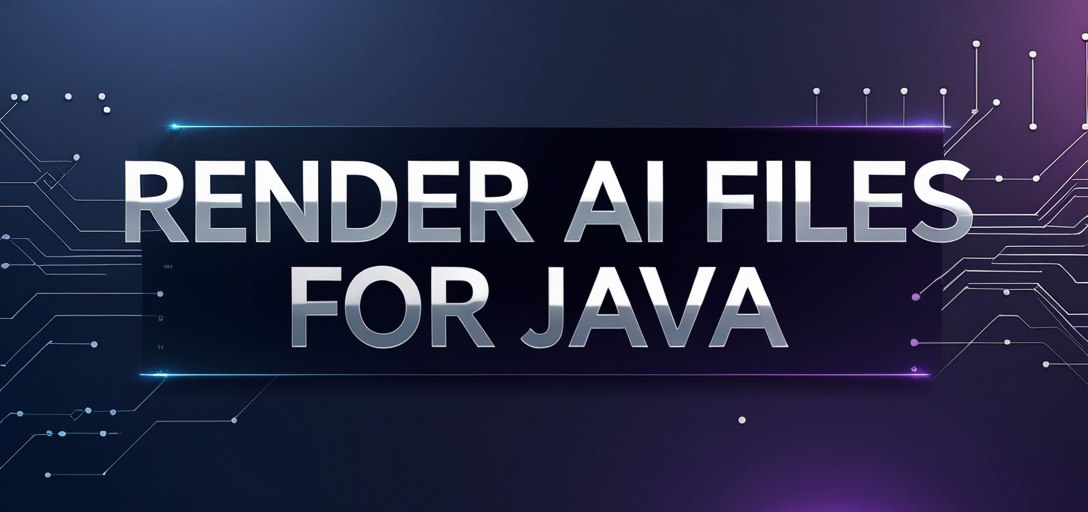Render AI Files Using GroupDocs.Viewer for Java: A Comprehensive Guide
Introduction
In the digital landscape, efficiently converting Adobe Illustrator (AI) documents into various formats is a crucial task for developers and businesses. Whether you need to display an AI file on a web page or convert it into high-resolution images or PDFs, the right tools are essential. GroupDocs.Viewer for Java offers a robust solution to this challenge, simplifying the process of converting AI files into HTML, JPG, PNG, and PDF formats.

This tutorial will guide you through using GroupDocs.Viewer for Java to perform these conversions seamlessly. By the end of this guide, you’ll be equipped with the knowledge needed to render AI files in multiple formats efficiently.
What You’ll Learn:
- Setting up GroupDocs.Viewer for Java
- Step-by-step instructions to convert AI documents into HTML, JPG, PNG, and PDF
- Practical applications and integration possibilities
- Performance optimization tips
Let’s start by checking the prerequisites before diving into implementation.
Prerequisites
To follow this tutorial effectively, ensure you have:
- Basic knowledge of Java programming.
- A working development environment with JDK installed.
- Maven set up for dependency management in your project.
Required Libraries and Dependencies
Include GroupDocs.Viewer as a dependency in your Maven pom.xml file. Here’s how to do it:
Maven Setup
<repositories>
<repository>
<id>repository.groupdocs.com</id>
<name>GroupDocs Repository</name>
<url>https://releases.groupdocs.com/viewer/java/</url>
</repository>
</repositories>
<dependencies>
<dependency>
<groupId>com.groupdocs</groupId>
<artifactId>groupdocs-viewer</artifactId>
<version>25.2</version>
</dependency>
</dependencies>
License Acquisition
GroupDocs.Viewer offers a free trial version for testing its capabilities. For long-term use, consider obtaining a temporary license or purchasing the software directly from their purchase page.
Setting Up GroupDocs.Viewer for Java
Let’s get started with setting up GroupDocs.Viewer in your Java project.
- Installation: Add the Maven dependency as shown above to include GroupDocs.Viewer.
- Initialization: Create a
Viewerinstance and use it within a try-with-resources block to ensure proper closure after execution.
Implementation Guide
Rendering AI Document to HTML
Overview: Convert an AI document into an HTML file, embedding all resources for easy web display.
Set Up Paths Define the output directory and resolve the path for your HTML file.
Path outputDirectory = Paths.get("YOUR_OUTPUT_DIRECTORY"); Path pageFilePathFormat = outputDirectory.resolve("ai_result.html");Initialize Viewer and Options Use
HtmlViewOptionsto specify that resources should be embedded within the HTML.try (Viewer viewer = new Viewer(TestFiles.SAMPLE_AI)) { HtmlViewOptions options = HtmlViewOptions.forEmbeddedResources(pageFilePathFormat); // Render the AI document to HTML with embedded resources. viewer.view(options); }
Key Configuration: The forEmbeddedResources method ensures that images and styles are included directly in the HTML file, simplifying web integration.
Rendering AI Document to JPG
Overview: Convert an AI document into a high-quality JPEG image for use in various applications like reports or presentations.
Set Up Paths
Path outputDirectory = Paths.get("YOUR_OUTPUT_DIRECTORY"); Path pageFilePathFormat = outputDirectory.resolve("ai_result.jpg");Initialize Viewer and Options
try (Viewer viewer = new Viewer(TestFiles.SAMPLE_AI)) { JpgViewOptions options = new JpgViewOptions(pageFilePathFormat); // Render the AI document to a JPG image. viewer.view(options); }
Key Configuration: JpgViewOptions is straightforward, focusing on rendering high-quality images.
Rendering AI Document to PNG
Overview: Similar to JPG but with lossless compression, ideal for maintaining quality in graphics-intensive applications.
Set Up Paths
Path outputDirectory = Paths.get("YOUR_OUTPUT_DIRECTORY"); Path pageFilePathFormat = outputDirectory.resolve("ai_result.png");Initialize Viewer and Options
try (Viewer viewer = new Viewer(TestFiles.SAMPLE_AI)) { PngViewOptions options = new PngViewOptions(pageFilePathFormat); // Render the AI document to a PNG image. viewer.view(options); }
Key Configuration: PngViewOptions ensures that all graphics are rendered with high fidelity.
Rendering AI Document to PDF
Overview: Convert an AI file into a universally accessible PDF format, perfect for sharing and printing documents.
Set Up Paths
Path outputDirectory = Paths.get("YOUR_OUTPUT_DIRECTORY"); Path pageFilePathFormat = outputDirectory.resolve("ai_result.pdf");Initialize Viewer and Options
try (Viewer viewer = new Viewer(TestFiles.SAMPLE_AI)) { PdfViewOptions options = new PdfViewOptions(pageFilePathFormat); // Render the AI document to a PDF file. viewer.view(options); }
Key Configuration: PdfViewOptions provides flexibility in rendering settings and output quality.
Practical Applications
- Web Development: Use HTML rendering for displaying vector graphics on websites without losing quality.
- Digital Marketing: Convert AI files to JPG or PNG for use in marketing materials like brochures and social media posts.
- Document Management Systems: Render PDFs for easy sharing, archiving, and printing of complex designs.
Performance Considerations
- Optimize Resource Usage: Ensure your application has adequate memory allocation when processing large AI files to prevent out-of-memory errors.
- Use Efficient File Handling: Close all streams properly to avoid resource leaks.
- Implement Caching: For repeated conversions of the same document, consider caching results to improve performance.
Conclusion
You’ve now mastered rendering AI documents into various formats using GroupDocs.Viewer for Java. These skills enable you to integrate versatile document viewing capabilities into your applications seamlessly. Explore further by experimenting with additional configuration options and integrating this functionality into larger projects.
Next Steps:
- Experiment with different document types beyond AI.
- Integrate the conversion process into a web application or desktop software.
- Explore GroupDocs.Viewer’s API for more advanced features like watermarking and custom rendering settings.
FAQ Section
What formats can I convert AI documents to using GroupDocs.Viewer?
- You can render AI files into HTML, JPG, PNG, and PDF formats.
Do I need a specific version of Java to use GroupDocs.Viewer?
- It’s recommended to use JDK 8 or higher for optimal performance and compatibility.
How do I handle large AI documents efficiently?
- Allocate sufficient memory and consider breaking down the document if possible.
Can I customize the output quality when converting to images?
- Yes, GroupDocs.Viewer provides options to adjust resolution and compression settings.
Is there support available for using GroupDocs.Viewer?
- Absolutely! Visit their support forum for assistance.
Resources
- Documentation: GroupDocs Viewer Java Documentation
- API Reference: API Reference Guide
- Download: GroupDocs.Viewer for Java